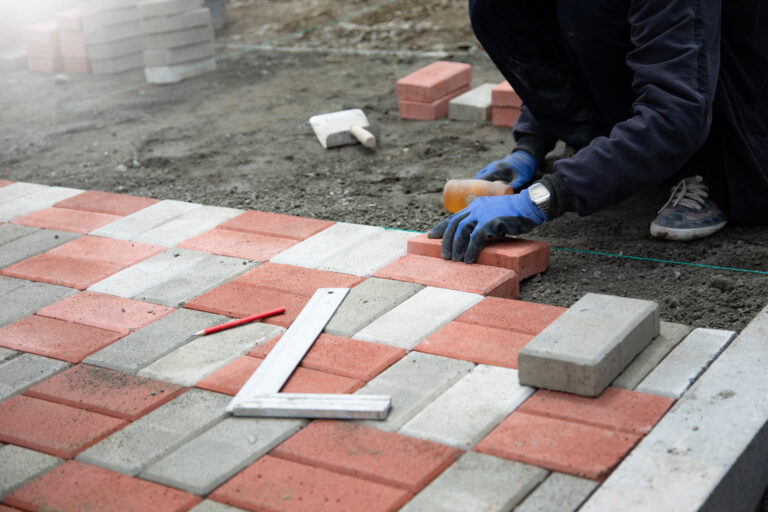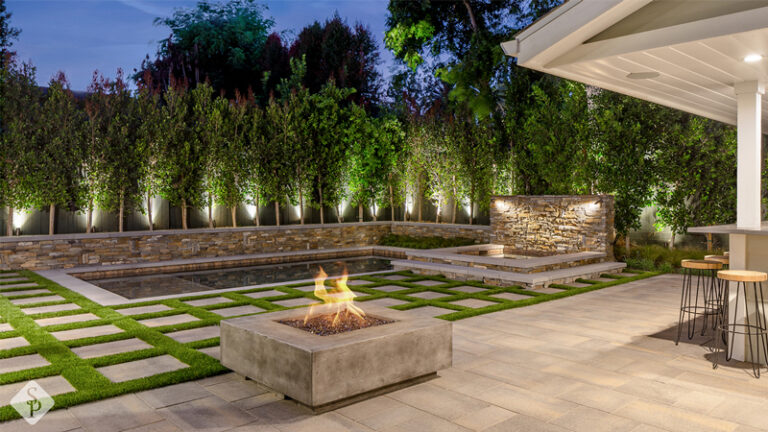How to Build a Backyard Fire Pit: A Clear Guide

Building a backyard fire pit is a great way to enhance your outdoor living space and create a cozy gathering spot for family and friends. With the right tools and materials, you can easily build a fire pit that will provide warmth and ambiance all year round. This article will provide step-by-step instructions on how to build a fire pit in your backyard, including important safety tips to keep in mind.
Before diving into the construction process, it’s important to consider the location of your fire pit. Choose a spot that is at least 10 feet away from any structures, trees or flammable materials. Check with your local fire department to see if there are any specific regulations or permits required for building a fire pit in your area. Once you have a suitable location, gather the necessary tools and materials, including bricks or pavers, a shovel, a level, and sand or gravel for the base.
Building a fire pit is a fun and rewarding DIY project that can be completed in a weekend. With the right preparation and attention to safety, you can create a beautiful and functional backyard feature that will be enjoyed for years to come. So, roll up your sleeves and get ready to build your own backyard fire pit with these easy-to-follow instructions.
Materials and Tools
Building a backyard fire pit requires a few essential materials and tools. Here are some of the most commonly used ones:
Materials
- Pavers: Pavers are a popular choice for the base of the fire pit. They come in various sizes, colors, and shapes, allowing you to create a customized look for your fire pit.
- Concrete: Concrete is a durable and affordable material that can be used to build the walls of the fire pit. It can be poured into molds or shaped by hand.
- Sand: Sand is used as a leveling agent for the pavers and as a base for the fire pit.
- Bricks: Bricks are a classic choice for building fire pits. They can be stacked to create a sturdy and durable structure.
- Steel fire ring: A steel fire ring is a pre-made ring that is placed inside the fire pit to contain the fire.
- Retaining wall blocks: Retaining wall blocks can be used to build the walls of the fire pit. They are available in a variety of colors and sizes.
- Glass: Glass can be used as a decorative element in the fire pit. It comes in various colors and can add a touch of elegance to your backyard.
- Propane or charcoal: Propane or charcoal can be used as a fuel source for the fire pit. Propane is a cleaner burning fuel, while charcoal produces a smoky flavor.
- Concrete pavers and cement wall blocks: Concrete pavers and cement wall blocks can be used to create a more modern look for your fire pit.
- Firebrick: Firebrick is a special type of brick that is designed to withstand high temperatures. It can be used to line the inside of the fire pit.
- Masonry adhesive: Masonry adhesive is used to hold the bricks or blocks together.
- Natural stone: Natural stone can be used to create a rustic or natural look for your fire pit.
Tools
- Shovel: A shovel is used to dig the hole for the fire pit and to move the sand and gravel.
- Level: A level is used to ensure that the pavers and blocks are level.
- Trowel: A trowel is used to spread the masonry adhesive.
- Rubber mallet: A rubber mallet is used to tap the pavers or blocks into place.
- Tape measure: A tape measure is used to measure the dimensions of the fire pit.
- Safety gear: Safety gear, such as gloves and safety glasses, should be worn when handling the materials and tools.
Related Posts:
Choosing the Right Location
Before building a backyard fire pit, it’s important to choose the right location. Here are a few things to consider:
- Local regulations: Check with your city or county to see if there are any regulations or permits required for building a fire pit in your backyard. Some areas may have specific rules regarding the location and size of fire pits.
- Safety: Choose a location that is away from any structures, trees, or other flammable materials. It’s also important to make sure the fire pit is on a level surface and not near any slopes or uneven terrain.
- Accessibility: Consider the location in relation to your home and outdoor living space. You’ll want to choose a spot that is easily accessible and convenient for you and your guests.
- Wind direction: Take note of the prevailing wind direction in your area. You don’t want smoke blowing into your home or outdoor living space.
- Aesthetics: Think about how the fire pit will fit into your backyard design. You may want to choose a location that complements your landscaping and outdoor decor.
By considering these factors, you can choose the perfect location for your backyard fire pit.
Related Posts:
Building the Fire Pit
Building a fire pit in your backyard can be a fun and rewarding DIY project. Before starting, it is important to choose the right location for your fire pit. Make sure it is at least 10 feet away from any structures and that there are no overhanging branches or nearby shrubs that could catch fire.
Foundation
The first step in building a fire pit is to create a foundation. This can be done with either pavers, gravel, or crushed stone. A solid foundation will prevent the fire pit from shifting or sinking over time.
Pavers
If you choose to use pavers for your foundation, start by digging a hole that is slightly larger than the size of your fire pit. Then, fill the hole with a layer of gravel and tamp it down. Next, lay the pavers in a circle on top of the gravel, making sure they are level. Finally, fill the gaps between the pavers with sand.
Stone or Concrete
Another option for a fire pit foundation is to use stone or concrete. This will create a more permanent structure that can withstand the elements. To build a stone or concrete fire pit, start by digging a hole that is slightly larger than the size of your fire pit. Then, pour a layer of concrete into the hole and smooth it out. Once the concrete has dried, lay the stones in a circle on top of the concrete, making sure they are level.
In-Ground Fire Pit
If you prefer an in-ground fire pit, start by digging a hole that is about 2 feet deep and 3 feet wide. Then, line the hole with fire-resistant bricks or stones. Fill the bottom of the hole with a layer of gravel and tamp it down. Finally, build a fire ring out of bricks or stones around the edge of the hole.
Masonry Fire Pit
For a more elaborate fire pit, consider building a masonry fire pit. This will require more time and effort, but the end result will be a beautiful and functional addition to your backyard. To build a masonry fire pit, start by creating a foundation using concrete and rebar. Then, build up the walls of the fire pit using fire-resistant bricks or stones, making sure to leave a gap for air flow.
Related Posts:
Fuel Options and Safety Tips
When it comes to fuel options for your backyard fire pit, there are several choices to consider. Each type of fuel has its own benefits and drawbacks, and it’s important to choose the one that best suits your needs.
Fire Rings
Fire rings are a popular choice for backyard fire pits. They are made of metal and can be used with a variety of fuels, including wood, charcoal, and propane. Fire rings are designed to contain the fire and prevent it from spreading beyond the designated area. They are also relatively easy to install and can be moved around if needed.
Natural Gas
If you’re looking for a more permanent option, natural gas might be the way to go. This type of fuel requires a gas line to be installed, but once it’s in place, you’ll have a reliable source of fuel for your fire pit. Natural gas is also clean-burning and produces less smoke than wood or charcoal fires.
Charcoal
Charcoal is a popular fuel option for grilling, but it can also be used in a fire pit. It produces a lot of heat and burns for a long time, making it a good choice for chilly evenings. However, it can be messy to deal with and requires some preparation before use.
Propane
Propane is another popular fuel option for fire pits. It’s easy to use and produces a clean-burning flame. Propane fire pits are also portable and can be moved around as needed. However, they require a propane tank to be installed, which can be costly.
Safety Tips
No matter what type of fuel you choose, it’s important to follow some basic safety tips when using a backyard fire pit. Here are a few things to keep in mind:
- Always keep a fire extinguisher or bucket of water nearby in case of an emergency.
- Don’t use flammable liquids, such as gasoline, to start the fire.
- Keep children and pets away from the fire pit.
- Never leave the fire unattended.
- Make sure the fire is completely extinguished before leaving it unattended or going to bed.
By following these safety tips and choosing the right fuel option for your needs, you can enjoy your backyard fire pit safely and responsibly.
Frequently Asked Questions
What materials do I need to build a fire pit?
To build a fire pit, you’ll need some basic materials such as bricks, concrete blocks, or pavers. You’ll also need a shovel, a level, and a tamper. Additionally, you may want to consider purchasing a fire pit ring, which can help contain the fire and protect the surrounding area.
How can I build a fire pit on a budget?
Building a fire pit on a budget is possible with some creativity and resourcefulness. Consider using recycled materials such as old bricks or stones, or look for deals on pavers or concrete blocks. You may also be able to find free materials on websites such as Craigslist or Facebook Marketplace. Keep in mind that safety should always be your top priority, so don’t skimp on materials that are essential for containing the fire and protecting your property.
What are some creative fire pit ideas?
There are endless possibilities for creative fire pit designs. Some popular options include building a fire pit into a retaining wall, using natural stone for a rustic look, or creating a modern design with sleek metal materials. You can also incorporate seating into your fire pit design, such as built-in benches or Adirondack chairs.
Is it necessary to use a fire pit ring?
While it’s not strictly necessary to use a fire pit ring, it can be a wise investment for safety and longevity. A fire pit ring helps contain the fire and prevents it from spreading beyond the designated area. It also protects the surrounding materials from heat damage, which can be especially important if you’re building your fire pit on a wooden deck or near other flammable materials.
What is the best base for a fire pit?
The best base for a fire pit is a level, stable surface that can withstand the heat of the fire. This can be a concrete slab, a layer of gravel or sand, or even a bed of compacted soil. Avoid building your fire pit on grass or other natural materials, as they can dry out and become a fire hazard.
How do I prepare my backyard for a fire pit installation?
Before installing a fire pit, it’s important to check with your local fire department to ensure that there are no restrictions or permits required in your area. You should also consider the location of your fire pit, making sure it’s at least 10 feet away from any structures or trees. Clear the area of any debris or flammable materials, and make sure the ground is level and stable. Finally, mark out the area where you plan to install the fire pit, using stakes and string to create a clear boundary.






